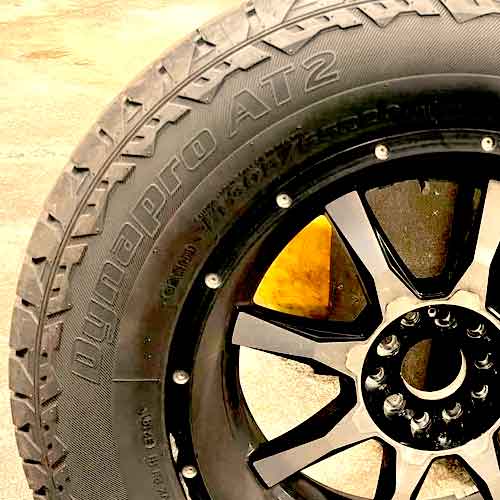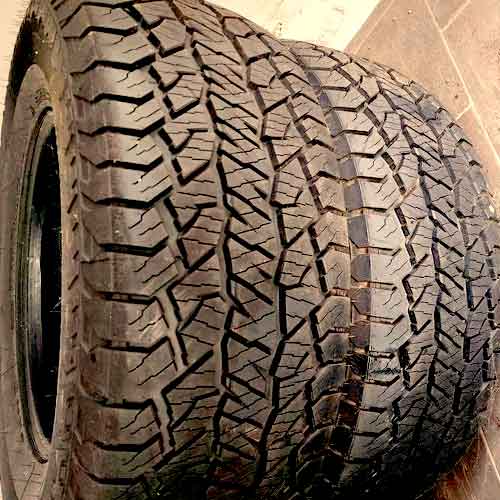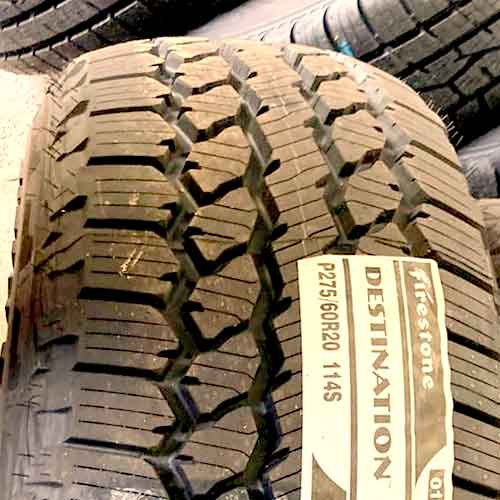Both the Firestone Destination AT2 and the Hankook Dynapro AT2 being all-terrain (A/T) tires, offer the best of both world (rugged terrains and highways), so you don’t really compromise a lot off road for on road comfort (and vice versa).

Being a tire engineer in my opinion, the Firestone Destination AT2 is the most fuel efficient tire that you can get. This is because the tire produces very low rolling resistance, (so good wear life as well) but that also means lower grip on dry compared to it’s wet (where it shines bright). The Hankook Dynapro AT2 on the other hand is great on dry highways but lacks on wet roads. The tire also does better overall on mud and rocks as well comparatively.
Table of Contents
Tire Sizes
Let’s start with Firestone Destination AT2 first.
- It comes with 55k miles warranty on all sizes, and they are all M+S and 3PMSF rated.
- All sizes (total 30) come in b/w 16″ to 20″.
- They get to have S or T speed ratings.
- And for Load ratings they only come with either XL or SL.
- So weight is kept in check, 29 lbs to 45 lbs.
- All sizes have tread depth of 12/32″.
Other the other hand, the Hankook Dynapro AT2 has…
- 90 total sizes coming in 15 to 22
- Speed ratings are seen with S, T and some also have H.
- Available load ratings of SL, XL, C to F.
- 27 to 80 lbs ranging weight.
- Tread Depth coming in from 12/32″ to 16.5/32″.
- 60k miles warranty on all sizes.
- All sizes rated with 3-peak mountain snowflake and M+S symbols.
Tire Structure
Starting with Hankook Dynapro AT2, the tire offers 4 longitudinal channels made out of 5 ribs.

Towards shoulders, the lugs are although not staggered they extend out towards sidewalls a little bit and make a pattern there which offers off road traction.
Towards inner edges, these lugs are equipped with off-set edges and full depth siping.
Also all these blocks are joined to each other with connector in between, (enhancing on road handling performance).
Towards middle, the tire presents 3 unique pairs of blocks of almost equal sizes, where the all of them are laced with full depth interlocking sipes, notches and off set edges (they all act as biters).
For your info: All paired blocks are actually joined from underneath with each other, with a rubber base that attracts directional stability on and off roads).
The middle most lugs also have “stairs-shaped” edges installed in their traction notches which further grip off road material.
If we take a look at it’s competitor, the Firestone Destination AT2.

This tire makes U shaped Lugs on sides which provide almost equal grabbing pull (comparatively). Though the outer edges of the shoulder lugs offers more biting edges (as each lug there is serrated on itself).
Towards inner edges, these shoulder lugs have full depth rectilinear siping and notches facing the central area of the tread.
Moreover, just like it’s competitor, the lugs are all joined together from underneath with rubber layer.
In the middle, the tire makes 3 ribs, where the outer ones have triangular stone ejectors in them. The central most rib is continuous and equipped with uncountable sipes (again full depth).
With so many sipes, at first it seems that the tire would do great in wet, but that’s not really the case, but more on that later.
For now, lets check out the internal make-up for both tires, where sidewalls are considered.
Sidewalls
The toughness of an all-terrain (A/T) tire is judged by looking at its internal construction, and here the sidewalls, as they are the most susceptible to damage, are considered the significant.
Externally both tires offers similar lugs on sides covering the bead area, so no protection comes from there, you can say (as thicker lugs deflect sharp encounters away, and form a thick wall in between). So both tires have to rely on their internal make-up.
The Firestone Destination AT2 offers 2 ply polyester casing with 2 steel belts and a single nylon ply, whereas the Hankook Dynapro AT2 comes with 2+2+2 construction, meaning it has 1 extra layer of nylon cap ply.
So if we just consider the sidewalls, both are 2 ply (as the other layers don’t cover the sides).
But still the Dynapro AT2 with an extra cap ply offers better puncture resistance form the middle as well, though both of them are cut resistant (needed for high speeding on gravel).
On Road Performance:
When it comes to all terrain tires, pavement and highway performance is not usually their strongest suit. But things changed when these two tires came in.
That’s because they are both very much aligned towards getting things better on smooth pavements, offering better grip, handling and steering response. Let’s discuss all.
Directional Grip
The directional grip is calculated by stopping distances and acceleration values of a tire.
Here the most important factor is how much of the tread meets up with the asphalt from the middle (along with other factors like tread’s composition, weight, rolling resistance and so on).
(Also, middle tread’s area is emphasized here because that makes the most solid grip with the surface).
Now here although both tires have secondary rubber layers underneath for pavement stability, the Hankook Dynapro AT2 shows better traction values (with shorter braking distances), that’s because the tire has a slightly rigid composition (which further adds to foundations underneath).
Moreover, the larger biters of the tire also ensures grip stays in tact with more force in comparison.
The Firestone Destination AT2 is also good enough, as it lacks in comparison due to it’s rubber contact offering, and one thing to note is that, it’s performance is affected further with increasing temperature, as it’s tread is not as thermo-adaptive as Dynapro.
Dry Handling
To understand the tire’s handling, it’s shoulders are considered. That’s because as the tire turns, most of the weight is emphasized on the sides of the tire (i.e shoulder lugs).
So looking at both tires, it again makes sense why Hankook Dynapro offers better cornering abilities with larger lateral g forces.
Basically the tire has paired blocks here without any tread features (so more of its tread’s rubber meets the surface its on).
Moreover, the lugs there are also slanted asymmetrically at a greater angle (and these offer a larger rolling forces).
Firestone Destination AT2 lacks here in comparison (though its not that bad overall compared to other AT tires).
Firestone basically focused on fuel efficiency a lot on this tire, ans because of this, the tire has lowered grip (in order to lower the rolling resistance).
Steering Communication
Having tested these tires on a (let’s just say) quite heavy SUV, where response times already were slower, I was impressed with the performance of both these tires.
Both of them were very direct and stable, where you can’t really put a finger on one being better, as I personally loved the understeer balance on Firestone Destination AT2, whereas the Hankook Dynapro AT2 provided with better lateral stability, easing in and out of corners smoothly.
Wet Traction
There are two key areas in wet traction where both do a similar job of wiping water off the tread.
They are wet grip and hydroplaning. Let’s talk about these one after another.
Wet Grip
The gripping of an all-terrain tire is not equally proportional to the rubber to road contact.
As here sipes play a bigger role of providing grip, and their structure and design helps a lot in underrating the overall traction. Basically sipes take water in their slits and throw it away as the tire move over.
So it makes sense why in comparison, the Firestone Destination AT2 is not only better here, but is also one of top performing ones because of it’s larger number of siping throughout its tread and a flexible rubber composition.
With more sipes, a bigger quantity of water is cleaned off and with flexibility, these sipes stay spongy to soak off the micro particles trapped underneath.
Hankook Dynapro AT2 on the other side also has a lot of sipes, but its tread does not provide them with highly needed softness, so they are too rigid to squeeze and slurp in the water particles and provide efficient grip.
Aquaplaning
Aquaplaning or hydroplaning happens (to the tire), when a thin layer of water comes in between the surface and the tread, resulting in lost traction.
A tire which can escape water out faster would be less prone to that. And faster the water leaves the tread, the less sipes have to work, so overall wet traction gets influenced.
So with lower resistance to aquaplaning the Hankook Dynapro AT2 further limits its’ wet traction.
Basically the tire has more closed up shoulders connected with ridges in between which don’t allow sideways removal of water.
The Firestone Destination on the other side, is slightly balder, and with open lugs, it produces better results.
Fuel Efficiency
With reduced rolling resistance values, the tire saves up a lot of CO2 emissions. Here although both tires come in the Class A category (which by the way goes up to E), the Firestone Destination AT2 offers better efficacy.
This is because its rubber compound is designed in a way which does not want to stick in with more friction, and although this compromises on it’s dry grip a little bit (as I explained above), the lesser rolling resistance of the tire consumes less overall fuel.
For Your Info: The EPA estimates that the U.S. could reduce greenhouse gas emissions 20% by 2030, simply by adopting more efficient tires.
Tread Life
Tread life or mileage of the tire although heavily depends on the way you drive, its influenced with other factors such as the rubber make up of the tread, it’s ability to wear out evenly, and tread depth.
With lower rolling resistance it makes sense that the Firestone Destination would wear slower, but with a softer make-up and lower tread depth the tire still shows less overall mileage in comparison.
That’s why this tire comes with 5k more mileage warranty, despite coming in with more weight and LT sizes.
Winter Performance
With powerful all-season traction capabilities, it’s not surprising that both of these tries are symboled with 3 Peak Mountain Snowflake and M+S ratings.
But still the Firestone Destination AT2 does things better with it’s flexible notches and a larger number of siping like a dedicated winter tire.
The Hankook Dynapro AT2 is a stiffer tire and with freezing temperatures, it gets even more harder, so snow grabbing is not as efficient in its case.
Off Road Traction
When it comes to off road, some terrains are very challenging, like mud, while others suit better to on road oriented tires like gravel and roads filled with dirt.
Let’s start with the toughest terrain.
On Mud
Mud is a very tough terrain. That’s the reason why mud-terrain tires are named with it, though they are more capable of performing on other terrains as well. But what makes M/Ts better here is faster mud evacuation.
With larger tread grooves, more mud is able to flow out of the tire in time, so it would not get packed.
The closed up tread design in AT tires makes them more susceptible to this. And both out tires are in that list.
They have secondary layers underneath the ribs and closed up shoulder lugs (with ridges in between), so mud has very little chance to move out, and as a result they get packed with it and loose traction.
For Your Info: Top performing A/T tire for mud is Goodyear Duratrac (review).
Rocks and Gravel
Speaking of rocks first (I mean climbing rocks by that), where you need solid sidewalls both internally and externally, and along with it powerful biters overall, the Hankook Dynapro AT2 does better here overall.
With availability in LT sizes, the tire is stronger, no doubt about it, and with number of biters across all its lugs, it’s not surprising that it shows better efficacy.
The Firestone Destination AT2 on the other side is better on gravely roads as it offers strong multiple stone ejectors strategically place in its outer circumferential channels.
On Sand
Sand requires airing down tires, so they could increase the overall tread print (which is very significant for this type of terrain).
Although with LT sizes, the Hankook Dynapro comes with stronger rim locks allowing you to air down the tire confidently, the tire also increases its weight significantly, so climbing on sand is challenging for it.
On the other side, the Firestone Destination AT2 with softer built offers a better contact area meet-up with the sand (with lowered pressure PSI values).
Key Takeaway
Both all-terrain (A/T) tires are although great on roads (as they are both highway performing oriented), the Firestone Destination AT2 is better on wet roads, whereas the Hankook Dynapro AT2 does great on dry highways.
Both are 3PMSF rated offering all season traction and off road they are again different where Dynapro offers better rock traction and Firestone give you a desirable experience on sand. But note that both are not preferable for muddy terrains, stating the obvious.